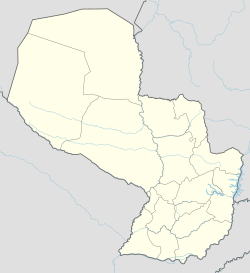Villeta
| Villeta | |
|---|---|
| Coordinates: 25°30′36″S 57°33′36″W / 25.51000°S 57.56000°WCoordinates: 25°30′36″S 57°33′36″W / 25.51000°S 57.56000°W | |
| Country | Paraguay |
| Department | Central |
| Founded | March 5th 1714 |
| Government | |
| • Intendente Municipal | Carlos Hugo Rojas Fernández (ANR) |
| Area | |
| • Total | 888 km2 (343 sq mi) |
| Elevation | 55 m (180 ft) |
| Population (2016) | |
| • Total | 36,985 |
| • Density | 25/km2 (60/sq mi) |
| Time zone | -4 Gmt |
| Postal code | 2680 |
| Area code(s) | (595) (225) |
| Climate | Cfa |
Villeta is a city of Paraguay in the Central Department, on the banks of Paraguay River. It is an important industrial center and port.
The city was founded on March 5, 1714, by Juan Gregorio Bazán de Pedraza, with the original name of San Felipe de Borbón del Valle del Bastán en los Campos del Guarnipitán (Saint Philip of Bourbon of the Valley of Bastan in the Fields of Guarnipitan), in homage to the King Felipe II. It was later renamed Villeta because of its resemblance to a great Villa.
The port is administered by the National Administration for Navigation and Ports (ANNP), and is specially equipped for the handling of heavy machinery. Many different kinds of merchandise are traded through this port.
Characteristics:
The temperature in summer sometimes reaches 40°C or higher. The minimum in winter is 0°C. The average for the entire Central Department is 22°C. The city is located in one of Paraguay's departments with the most rainfall during the months from January to April; and the least during the months from June to August.
The total population of the city is 36,228 inhabitants, 18,362 males and 17,866 females, according to the data from the General Directorate of Statistics, Polls and Census.
Villeta was founded in 1714 by the Governor Juan Gregorio Bazán de Pedraza. During the government of Dr. Francia, the city became an important conduit for communication with other countries, making the economic development of the district possible.
Until 1930 the city was famous because of activity at the port, mostly the export of oranges. Today the port is used for multiple purposes.
Villeta's port on the banks of the Paraguay River is the shipping point for most of Paraguay's exports. Nineteen large factories located in the area produce cement, iron rods, cotton, electric cables, and agricultural chemicals, and other activities. The cement and chemical plants are infamous for the environmental contamination they cause.
The major processing plant for Paraguay's cement industry is located in Villeta.
There are several historic buildings in the city. The Church of the Virgin of the Rosary (Virgen del Rosario), built during the period of the Paraguayan War also served as a Hospital, and is one such edifice. The architecture of the church is an example of the distinctive characteristics of 19th-century art in Paraguay, especially in the murals painted by Adán Kunos.
...
Wikipedia

